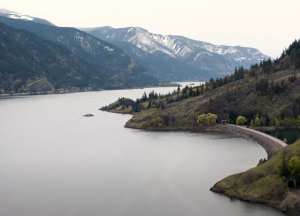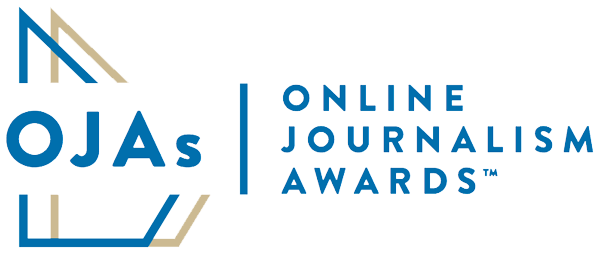
Judges for the 2023 Online Journalism Awards praised the film Wy-Kan-Ush-Pum (Salmon People) as an “immensely captivating” view into a more than century-long fight for salmon survival and the right to fish. Produced by Oregon Public Broadcasting (OPB) and ProPublica, the documentary film was part of an 18-month reporting collaboration to investigate how the decline of salmon populations are impacting Indigenous communities in the Pacific Northwest. It was honored as winner in the Digital Video Storytelling category of the 2023 OJAs.
OPB Investigative Reporter Documentary Tony Schick and ProPublica Documentary Filmmaker Katie Campbell made up the core team that produced the documentary, with support by editors and executive producers at both organizations. Katie generously shared with ONA about the team’s motivations and the careful process that elevated their effort to award-worthy journalism.
This post is based on a Q&A that has been edited for length and clarity.
Our overall goal with the project was to explain the way treaties have been violated over the nearly 170 years since they were signed and to reveal the present-day consequences of those violations. But as filmmakers, we also hoped to move audiences on an emotional level by showing the significance of salmon in the daily lives of Pacific Northwest tribal people.
Our film, “Wy-Kan-Ush-Pum / Salmon People,” started with the idea that while the destruction of salmon in the Pacific Northwest has been well-covered, there is still a lot left to say about the failures of the U.S. government to live up to its commitments to Indigenous tribes of the United States. And time is running out for salmon recovery efforts. After decades of pollution and overfishing, numbers of salmon species native to the Columbia River basin have dropped to a fraction of what they once were, with 13 distinct populations now considered threatened or endangered. Climate change stands to make things even worse. Warming ocean temperatures are predicted to cause salmon survival to decline by roughly 90% within the next 40 years.
 The U.S. government signed treaties with tribes in the Pacific Northwest in 1855, amassing millions of acres of land for new settlers. Some tribes were forced to sign treaties under the threat of violence. In exchange for their land, hundreds of tribes retained the rights to critical natural resources, including fresh water and salmon. But the U.S. government broke those agreements, repeatedly.
The U.S. government signed treaties with tribes in the Pacific Northwest in 1855, amassing millions of acres of land for new settlers. Some tribes were forced to sign treaties under the threat of violence. In exchange for their land, hundreds of tribes retained the rights to critical natural resources, including fresh water and salmon. But the U.S. government broke those agreements, repeatedly.
For the tribes of the Pacific Northwest, the destruction of salmon is not only historical—it is happening now, and it will have a major impact on the health and wellbeing of current and future generations.
Our overall goal with the project was to explain the way treaties have been violated over the nearly 170 years since they were signed and to reveal the present-day consequences of those violations.
But as filmmakers, we also hoped to move audiences on an emotional level by showing the significance of salmon in the daily lives of Pacific Northwest tribal people. They don’t just eat fish. They rely on salmon for a significant portion of their diet. It’s also their main source of income. And it’s the bedrock of their religious and cultural practices.
We set out to present one tribal family’s experience: their joy and pride in a traditional way of life; their anger and defiance at a legacy of betrayal; and the fear and resilience they express.
The voices in the film gave meaning to all the accountability reporting that had come earlier. Statistics and facts are crucial to measuring problems in our world, but they often fail at conveying the extent of wrongdoing and harm that has occurred.
The challenge we gave ourselves was to create a documentary film that features the plight of the salmon of the Columbia River and the Native people whose lives revolve around them. Through this film, we wanted viewers to witness the firsthand experience of people who are watching their way of life disappear.
Work on the film took place over 16 months from August 2021 to December 2022. During that time we spent several weeks on pre-production research and development of relationships with the Columbia River tribal fishing community, including spending dozens of hours with tribal leaders; attending tribal council meetings and introducing our project. We listened and answered questions as tribal leaders asked about our intentions, reporting processes and goals.
Those meetings helped us keep tribal members’ concerns and voices at the center of our work and led to an introduction to tribal fisherman Randy Settler, who would become a main character in our film. Randy had been fighting for tribal fishing rights for decades. His great-great-great-grandfather was one of the signers of the treaties and his parents had been arrested and jailed several times for fishing that was protected by treaties. Randy introduced us to his fishing crew, three generations of family members—the youngest being 9-year-old Aiyana, who was standing ready to inherit her family’s struggle.
We spent 35 days in the field filming Randy’s family and crew over an entire season of salmon fishing, documenting their day-to-day lives. It was important to us to make our journalistic process both transparent and participatory. We checked in often and reported on the progress we were making. As we got closer to publication, we talked with our participants about the framing of the film and about how they would be presented as storytellers in the project.
Journalists like to work fast, efficiently and at a distance. That approach wouldn’t work here.
We then spent five months in post-production and hired an independent Indigenous video editor, Dewi Sungai Marquis, who has spent years producing Native American documentary-style films. We also hired musicians from the tribe to contribute music to the film and collaborated with Indigenous people from the Pacific Northwest to serve as cultural and language experts, providing us feedback prior to publication to help us avoid mistakes, misspellings and cultural faux pas.
Reporting on and making films about Native American communities is difficult for many journalists, and with good reason. Interviews can feel extractive, putting the needs of the journalist ahead of the needs of the people at the heart of the story. To do this project, we were going to have to rethink many journalistic values and practices.
To start, journalists like to work fast, efficiently and at a distance. That approach wouldn’t work here. Historically, tribal members told us, they felt that journalists typically ignored or misrepresented them. Establishing trust would require getting to know people and allowing them to get to know us. We would not be able to do this from afar. Tribal individuals often didn’t respond to phone calls or emails; they would make time for us only if a community-member vouched for us and if we met in person. We spent many days in the field listening to tribal members’ concerns and learning about their lives. We worked slowly and deliberately before picking up a pen or a camera.
In interviews, journalists also tend to ask people to talk about themselves. But we learned that it can be seen as disrespectful among tribal members to talk about one’s own experiences first. We weren’t going to be able to ask them directly about the work they’d done, or their feelings, without making space for them to talk first about ancestors, other tribes or even on behalf of the environment or animals.
At first, some of our film participants were reluctant to participate in on-camera interviews, so we recorded several interviews as audio-only to help them feel comfortable enough to speak frankly. Randy later acknowledged that he had shared thoughts and experiences with us that he had never spoken of openly before.
Additionally, as journalists, unfettered access to people and places is key. We can treat the places we enter as fair game for interviews, photography and filming. But this was not appropriate in tribal spaces. There are places only Native people are allowed and where photography is not permitted. As we entered sacred spaces and important fishing sites, we were going to have to put down the cameras, to be in the moment, and to pick up again only when we had permission.
 Some of these conflicting values were apparent early; others emerged as our relationships with tribal members deepened. Perhaps the most significant was how to maintain our journalistic distance even while building trust.
Some of these conflicting values were apparent early; others emerged as our relationships with tribal members deepened. Perhaps the most significant was how to maintain our journalistic distance even while building trust.
Our sources would invite us to join them for meals, memorials and naming ceremonies typically reserved for close family and friends. After a year of working together, they were adamant that we sit with them on the floor of the longhouse and partake in the traditional first foods feast even as they asked us not to film it. We had become a part of their inner circle. They also often gave us food and salmon. As journalists we are not supposed to accept gifts, but when we tried to refuse salmon from Randy, he was really hurt. “You are insulting me,” he said. Being generous and sharing what you have is a critical part of tribal culture. To honor their culture, we accepted the salmon, and found ways to reciprocate their generosity.
Launched in 2000, the Online Journalism Awards are the only comprehensive set of journalism prizes honoring excellence and innovation in digital journalism around the world.
Explore all 2023 winners and finalistsThe Online Journalism Awards™ (OJAs), launched in May 2000, are the only comprehensive set of journalism prizes honoring excellence in digital journalism around the world.

Posted By
Karolle Rabarison
Categories
Stories